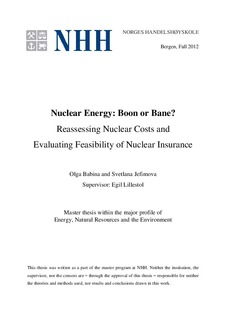| dc.contributor.author | Babina, Olga | |
| dc.contributor.author | Jefimova, Svetlana | |
| dc.date.accessioned | 2013-01-15T08:52:43Z | |
| dc.date.available | 2013-01-15T08:52:43Z | |
| dc.date.issued | 2012 | |
| dc.identifier.uri | http://hdl.handle.net/11250/169989 | |
| dc.description.abstract | In the next 20 years, the demand for energy is anticipated to grow by 40 per cent. All available energy sources would need to be leveraged in order to satisfy the growing demand, however, in reality it does not happen. The fossil fuels are considered for a gradual phase-out and the likelihood of a massive expansion of renewable energy is also doubtful. The outlook for nuclear energy is gloomy due to people’s concern that it is not safe and that a nuclear disaster would cause severe damage. While the previous studies support the above, several new studies suggest the opposite. This paper assesses the cost of a nuclear disaster through a hypothesized nuclear disaster at Olkiluoto-3 power plant in Finland and finds that the previously reported nuclear costs might be overstated. Furthermore, this study analyses the international third party liability laws on nuclear energy and concludes that they have been consistently failing. Finally, this study finds that insuring against a nuclear disaster is feasible but currently not manageable. Based on the findings, this paper derives eight implications for the consideration of associated stakeholders and urges for a constructive discussion. | no_NO |
| dc.language.iso | eng | no_NO |
| dc.subject | energy, natural resources and the environment | |
| dc.title | Nuclear energy: boon or bane? : reassessing nuclear costs and evaluating feasibility of nuclear insurance | no_NO |
| dc.type | Master thesis | no_NO |
| dc.subject.nsi | VDP::Social science: 200::Economics: 210::Economics: 212 | no_NO |
| dc.subject.nsi | VDP::Technology: 500::Electrotechnical disciplines: 540 | no_NO |
